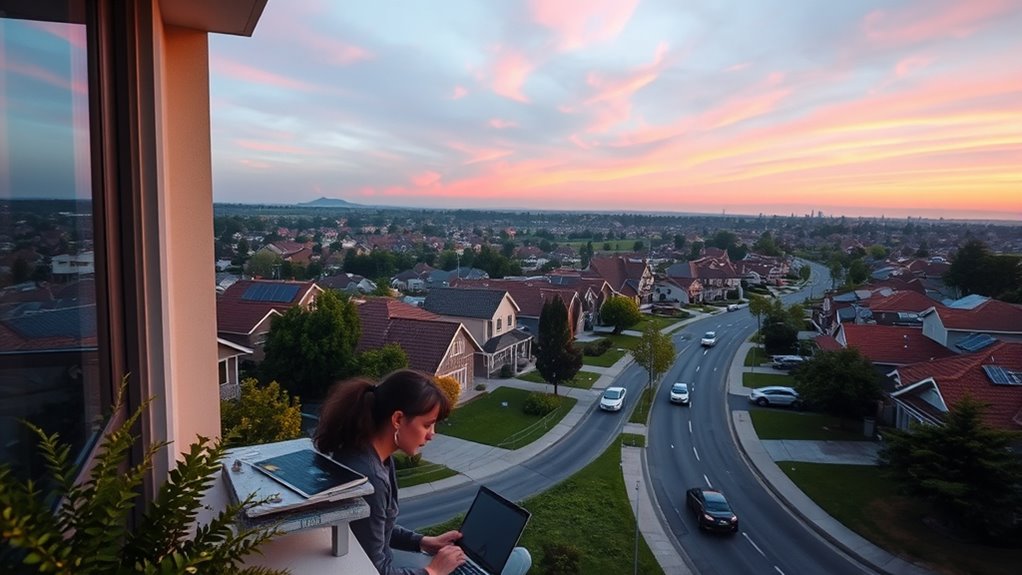In 2025, remote work’s environmental benefits surprise many, as it reduces emissions from daily commutes and cuts urban congestion, leading to better air quality. However, increased energy use at home can offset these gains, especially if households aren’t energy-efficient. It may also affect public transit funding, potentially shifting reliance back to personal vehicles. To understand how these factors balance out and what it means for the environment, keep exploring the details ahead.
Key Takeaways
- Remote work significantly reduces commuting emissions, lowering greenhouse gases and urban air pollution in 2025.
- Energy consumption shifts from office buildings to homes, potentially increasing residential energy use and environmental impact.
- Decreased urban congestion improves air quality but may lead to reduced investment in public transportation infrastructure.
- Online activities and home energy needs can offset some environmental benefits of telecommuting.
- Long-term urban planning is essential to balance reduced traffic with sustainable transportation and infrastructure development.

Remote work has become increasingly popular, and with it, its impact on the environment has garnered attention. When you work from home, you naturally reduce your carbon footprint by cutting down on the emissions generated from daily commutes. Fewer cars on the road mean less exhaust fumes and greenhouse gases contributing to climate change. This decrease in transportation-related emissions is one of the most noteworthy environmental benefits of remote work. Additionally, with fewer people traveling into city centers, urban congestion diminishes. Less traffic congestion not only shortens travel times but also reduces the idling of vehicles, which is a major source of pollution. As a result, air quality improves, and cities experience less smog and pollution-related health issues.
In your daily routine, working remotely allows you to avoid the rush hour gridlock, reducing the amount of time you spend stuck in traffic. This doesn’t just benefit the environment; it also benefits your stress levels and productivity. Less congestion means fewer stop-and-go traffic patterns that waste fuel and increase vehicle emissions. Consequently, your overall carbon footprint shrinks because you’re not contributing to the cycle of urban congestion and pollution. Besides transportation, remote work can also lead to a decrease in the energy consumption of office buildings, which are typically less energy-efficient than homes. When fewer people occupy office spaces, energy used for lighting, heating, cooling, and equipment drops considerably. Moreover, the adoption of energy-efficient appliances at home can further mitigate increased energy use, making remote work more sustainable.
However, it’s not all positive. The environmental benefits of remote work can be offset by increased energy use at home, especially if your house isn’t well-insulated or energy-efficient. Heating or cooling an entire house can consume more energy than a single office room, depending on your habits and appliances. Additionally, the surge in online activities, like video conferencing and cloud computing, requires substantial electricity, which in many regions is still generated from fossil fuels. This shift can partially negate the reductions gained from decreased commuting.
Furthermore, the decrease in urban congestion might lead to less investment in public transportation infrastructure, which could have long-term environmental impacts if cities don’t adapt their transit systems accordingly. If remote work becomes the norm without proper planning, some urban areas might see a decline in public transit use, reducing funding and leading to more reliance on personal vehicles for essential trips.
Frequently Asked Questions
How Does Remote Work Influence Urban Air Quality?
You might notice that remote work improves urban air quality by reducing traffic emissions, leading to less urban noise and cleaner air. With fewer commuters, access to green spaces increases as cities can reallocate resources, encouraging outdoor activities and improving overall well-being. This shift helps decrease pollutants, making cities healthier and quieter. So, working remotely benefits not just your productivity but also the environment and your urban living experience.
What Impact Does Remote Work Have on Local Biodiversity?
Imagine your daily commute as a river flowing through an urban jungle, disrupting urban flora and wildlife corridors. When you work remotely, you reduce this flow, allowing nature to reclaim spaces. Less traffic means fewer disturbances for local biodiversity, fostering healthier habitats and reconnecting fragmented ecosystems. Your choice to work from home can help preserve urban biodiversity by minimizing habitat fragmentation and supporting vibrant urban flora and wildlife corridors.
Are There Energy Savings in Data Centers Due to Remote Work?
You’ll find that remote work can lead to notable energy savings in data centers. When fewer employees work on-site, office energy use drops, reducing overall demand. This shift can improve data center efficiency because less infrastructure is needed to support large office buildings, lowering energy consumption. As a result, data centers operate more effectively, contributing to reduced carbon footprints and making remote work a more sustainable option overall.
How Does Remote Work Affect Global Transportation Emissions?
You notice that remote work considerably reduces commuting, leading to lower transportation emissions globally. With fewer people traveling daily, emissions from personal vehicles drop along with public transit usage. Additionally, freight transportation decreases as businesses ship fewer goods. This overall reduction in transportation activity helps cut greenhouse gases, making a positive environmental impact. While some freight may shift to other routes, the net effect is a notable decrease in global transportation emissions.
What Are the Long-Term Effects of Remote Work on Environmental Policy?
Did you know that 68% of organizations expect remote work to influence future policies? You’ll see policy shifts aimed at supporting long-term sustainability, such as incentives for green commuting options and remote work-friendly regulations. These changes encourage businesses and governments to adopt environmentally conscious practices, ensuring that remote work’s benefits are preserved over time. Your role in advocating for these policies can help shape a sustainable, adaptable future.
Conclusion
As you embrace remote work, you can see how it’s a double-edged sword—cutting down on emissions but sometimes creating new challenges. Remember, every coin has two sides, and your choices can tip the scales. By staying mindful of your habits, you can help turn the tide in favor of the environment. So, keep your eye on the prize and make small changes; even the tallest oak starts from a tiny acorn.









